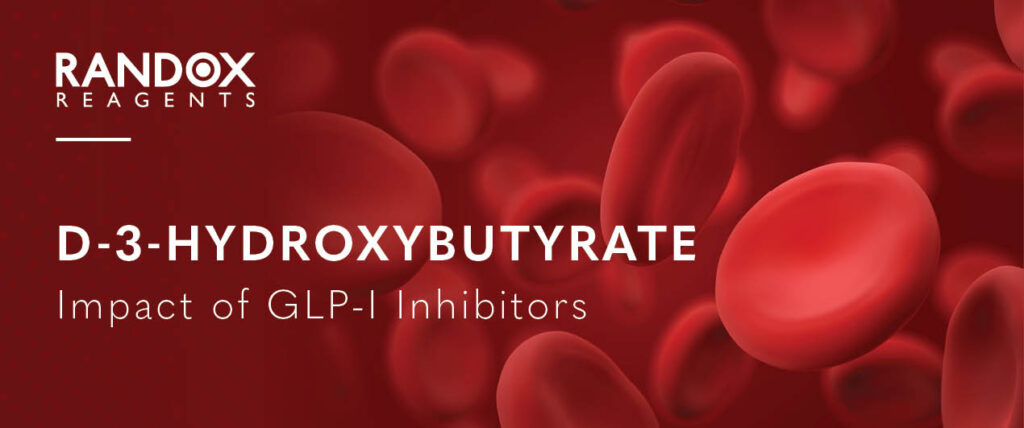Impact of GLP-I Inhibitors & the Role of D-3-Hydroxybutyrate Testing

D-3-Hydroxybutyrate (BHB) is the most abundant of the three main ketone bodies produced during ketosis, accounting for around 75% of total ketones in the body. While ketosis itself is a normal metabolic response to low glucose availability, unchecked ketone accumulation—particularly in diabetes—can progress to ketoacidosis, a serious and potentially life-threatening condition.
Why testing Matters?
BHB is the primary marker for diagnosing and monitoring ketoacidosis because it represents the largest fraction of circulating ketones. Measuring BHB levels provides clinicians with a direct and reliable assessment of ketone status—essential for differentiating safe, nutritional ketosis from dangerous diabetic ketoacidosis (DKA).
Randox is a leading global provider of beta-hydroxybutyrate assays, widely used in clinical chemistry laboratories globally.
Ketosis vs. Ketoacidosis
| Ketosis | Ketoacidosis |
| The body burning fat for “fuel” instead of sugars. | Excessive rise in ketones, as sugars depleted and the pH balance in the blood is upset with more acidic blood |
| Ketones produced (BHB) as the alternative energy source | Result of :
Diabetic Ketoacidosis (DKA) – insulin deficiency (type 1, some type 2, SGLT2 use, GLP-1 related fasting/ illness)
Starvation Ketoacidosis
Alcoholic Ketoacidosis |
| This happens through overnight fasting/ prolonged exercise, low carb or keto diets or illnesses (mild) | Too many ketones made – which are acidic chemicals produced when fats are broken down for energy. These acids build up in the blood faster than the body can neutralise them |
| BHB levels are mildly elevated | BHB levels are high to significantly higher |
| Blood pH level is normal (acid/ alkaline balance) | Blood pH is low (more acidic), bicarbonate in the blood trying to neutralise this becomes overwhelmed (as ketones being produced faster) – bicarbonate levels drop and as a result metabolic acidosis occurs |
| Generally, not dangerous | Medical emergency – dehydration, electrolyte imbalances, shock and can lead to death
Acidosis impacts normal cell function & heart rhythm Dehydration & electrolyte loss (especially potassium) has further impact |
GLP-1 Inhibitors and Ketoacidosis: A Growing Concern
GLP-1 receptor agonists (GLP-1 RAs) are revolutionising the management of type 2 diabetes and obesity. These drugs improve blood sugar control, reduce appetite, and promote significant weight loss.
However, as their use expands rapidly across the US, UK, and globally, emerging data highlight a potential link between GLP-1 therapy and ketoacidosis, even in the absence of high blood glucose (a condition known as euglycaemic ketoacidosis).
How GLP-1 Drugs Can Contribute
- Reduced food intake and fluid consumption (from nausea or GI upset)
- Dehydration
- Lowered insulin levels
- Increased glucagon secretion
- Rapid reduction or discontinuation of insulin therapy
Regulatory bodies—including the MHRA (UK), EMA (Europe), and FDA (US)—issued safety bulletins (2023–2025) urging clinicians to remain alert for ketoacidosis symptoms even in patients with normal glucose levels on GLP-1 therapy.
With the widespread adoption of GLP-1 therapies, healthcare professionals should remain vigilant for ketoacidosis, even in non-diabetic or well-controlled diabetic patients. Incorporating beta-hydroxybutyrate testing into standard diagnostic panels helps ensure early detection and appropriate management—ultimately improving patient safety. BHB testing is increasingly being incorporated into emergency and primary care workups, particularly when symptoms suggest possible ketoacidosis.
Benefits of the Randox assay
Superior Methodology
As the most abundant ketone produced during ketosis, D-3-hydroxybutyrate is more sensitive and specific when compared to the commercially available nitroprusside method.
Exceptional Correlation
A correlation coefficient of r=0.9954 was displayed when the Randox method was compared against other commercially available methods.
Excellent Precision
The Randox Ranbut assay displayed an excellent precision of <3.5%.
With a wide range of Instrument Specific Applications available, the Randox D-3-Hydroxybutyrate assay is a superior marker to add to any laboratory environment.